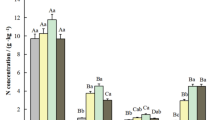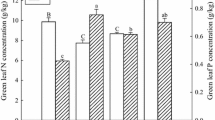Abstract
Although carbon (C), nitrogen (N), and phosphorous (P) stoichiometric ratios are considered good indicators of nutrient excess/limitation and thus of ecosystem health, few reports have discussed the trends and the reciprocal effects of C:N:P stoichiometry in plant–litter–soil systems. The present study analyzed C:N:P ratios in four age groups of Chinese pine, Pinus tabulaeformis Carr., forests in Shanxi Province, China: plantation young forests (AY, < 20 year-old); plantation middle-aged forests (AM, 21–30 year-old); natural young forests (NY, < 30 year-old); and natural middle-aged forests (NM, 31–50 year-old). The average C:N:P ratios calculated for tree, shrub, and herbaceous leaves, litter, and soil (0–100 cm) were generally higher in NY followed by NM, AM, and AY. C:N and C:P ratios were higher in litter than in leaves and soils, and reached higher values in the litter and leaves of young forests than in middle-aged forests; however, C:N and C:P ratios were higher in soils of middle-aged forests than in young forests. N:P ratios were higher in leaves than in litter and soils regardless of stand age; the consistent N:P < 14 values found in all forests indicated N limitations. With plant leaves, C:P ratios were highest in trees, followed by herbs and shrubs, indicating a higher efficiency in tree leaf formation. C:N ratios decreased with increasing soil depth, whereas there was no trend for C:P and N:P ratios. C:N:P stoichiometry of forest foliage did not exhibit a consistent variation according to stand age. Research on the relationships between N:P, and P, N nutrient limits and the characteristics of vegetation nutrient adaptation need to be continued.






Similar content being viewed by others
References
Aerts R, Chapin FS III (1999) The mineral nutrition of wild plants revisited: A re-evaluation of processes and patterns. Adv Ecol Res 30:1–67
Ågren GI (2004) The C:N:P stoichiometry of autotrophs-theory and observations. Ecol Lett 7:185–191
Ågren GI (2008) Stoichiometry and nutrition of plant growth in natural communities. Annu Rev Ecol Evol Syst 39:153–170
Batjes NH (1996) Total carbon and nitrogen in the soils of the world. European Journal of Soils Science 47:151–163
Chapin FS III, Moilanen L (1991) Nutritional controls over nitrogen and phosphorus resorption from Alaskan birch leaves. Ecology 72:709–715
Chapin FS III, Matson PA, Vitousek PM (2011) Principles of terrestrial ecosystem ecology. Springer, New York
Davidson EA, de Carvalho CJR, Figueira AM, Ishida FY, Ometto JPHB, Nardoto GB, Sabá RT, Hayashi SN, Leal EC, Vieira ICG, Martinelli LA (2007) Recuperation of nitrogen cycling in Amazonian forests following agricultural abandonment. Nature 447:995–998
De Camargo PB, Trumbore SE, Martinelli LA, Davidson ECA, Nepstad DC, Victoria RL (1999) Soil carbon dynamics in regrowing forest of eastern Amazonia. Glob Change Biol 5:693–702
Elser JJ, Acharya K, Kyle M, Cotner J, Makino W, Markow T, Watts T, Hobbie S, Fagan W, Schade J, Hood J, Sterner RW (2003) Growth rate-stoichiometry couplings in divers biota. Ecol Lett 6:936–943
Elser JJ, Bracken MES, Cleland EE, Gruner DS, Harpole WS, Hillebrand H, Ngai JT, Seabloom EW, Shurin JB, Smith JE (2007) Global analysis of nitrogen and phosphorus limitation of primary production in freshwater, marine, and terrestrial ecosystems. Ecol Lett 10:1135–1142
Fang YT, Mo JM, Peng SL, Li DJ (2003) Role of forest succession on carbon sequestration of forest ecosystems in lower subtropical China. Acta Ecol Sin 23:1685–1694 (in Chinese)
Feng JC (2010) Carbon storage of forest vegetation in Shanxi Province. Shanxi Forestry Science and Technology 39:16–18 (in Chinese)
Forest Resources Management Department (2003) The National Forest Inventory (NFI) technical regulations, revised edn. China State Forestry Administration, Beijing (in Chinese)
Frost PC, Evans-White MA, Finkel ZV, Jensen TC, Matzek V (2005) Are you what you eat? Physiological constraints on organismal stoichiometry in an elementally imbalanced world. Oikos 109:18–28
Goddert VO, Power SA, Falk K, Friedrich U, Mohamed A, Krug A, Boschatzke N, Härdtle W (2010) N:P ratio and the nature of nutrient limitation in Calluna-Dominated Heathlands. Ecosystems 13:317–327
Güsewell S (2004) N:P ratios in terrestrial plants: Variation and functional significance. New Phytol 164:243–266
Güsewell S, Koerselman W, Verhoeven JTA (2003) Biomass N:P ratios as indicators of nutrient limitation for plant populations in Wetlands. Ecol Appl 13:372–384
Han WX, Fang JY, Guo DL, Zhang Y (2005) Leaf nitrogen and phosphorus stoichiometry across 753 terrestrial plant species in China. New Phytol 164:243–266
Han WX, Wu Y, Tang LY, Chen YH, Li LP, He JS, Fang JY (2009) Leaf carbon, nitrogen and phosphorus stoichiometry across plant species in Beijing and its periphery. Acta Scientiarum Naturalum Unicersitais Pekinensis 45:855–860
He JS, Fang JY, Wang Z, Guo D, Flynn DFB, Gerg Z (2006) Stiochiometry and large-scale patterns of leaf carbon and nitrogen in the grassland biomes of China. Oecologia 149:115–122
He JS, Wang L, Flynn DFB, Wang XP, Ma WH, Fang JY (2008) Leaf nitrogen: Phosphorus stoichiometry across Chinese grassland biomes. Oecologia 155:301–310
Hessen DO, Ågren GI, Anderson TR, Elser JJ, de Ruiter PC (2004) Carbon sequestration in ecosystems: The role of stoichiometry. Ecology 85:1179–1192
Hogan EJ, Minnullina G, Smith RI, Crittenden PD (2010) Effects of nitrogen enrichment on phosphatase activity and nitrogen: Phosphorus relationships in Cladonia portentosa. New Phytol 186:911–925
Huang CY (2000) Pedology. Chinese Agricultural Press, Beijing (in Chinese)
Koerselman W, Meuleman AFM (1996) The vegetation N:P ratio: A new tool to detect the nature of nutrient limitation. J Appl Ecol 33:1441–1450
Lal R (2004) Soil carbon sequestration impacts on global change and food security. Science 304:1623–1627
Marschner H (1995) Mineral nutrition of higher plants. Academic Press, New York
McGroddy ME, Daufresne T, Hedin LO (2004) Scaling of C:N:P stoichiometry in forests worldwide: Implications of terrestrial redfield-type ratios. Ecology 85:2390–2401
Niinemets U, Kull O (1999) Biomass investment in leaf lamina versus lamina support in relation to growth irradiance and leaf size in temperate deciduous trees. Tree Physiol 19:349–358
Niva M, Svensson BM, Karlsson PS (2003) Nutrient resorption from senescing leaves of the clonal plant Linnaea borealis in relation to reproductive state and resource availability. Funct Ecol 17:438–444
Richardson SJ, Allen RB, Doherty JE (2008) Shifts in leaf N:P ratio during resorption reflect soil P in temperate rainforest. Funct Ecol 22:738–745
State Forestry Administration (1999) Forest soil analysis method (the forestry industry standard of the People’s Republic of China). Standards Press of China, Beijing (in Chinese)
Sterner RW, Elser JJ (2002) Ecological stoichiometry: The biology of elements from molecules to the biosphere. Princeton University Press, Princeton, NJ
Stevenson FJ, Cole MA (1999) Cycles of soil carbon, nitrogen, phosphorus, sulfur, micronutrients. Wiley, Hoboken
Tessier JT, Raynal DJ (2003) Use of nitrogen to phosphorus ratios in plant tissue as an indicator of nutrient limitation and nitrogen saturation. J Appl Ecol 40:523–534
Wang SQ, Yu GR (2008) Ecological stoichiometry characteristics of ecosystem carbon, nitrogen and phosphorus elements. Acta Ecol Sin 28:3937–3947 (in Chinese)
Wang JY, Wang SQ, Li RL, Yan JH, Sha LQ, Han SJ (2011) C:N:P stoichiometric characteristics of four forest types’ dominant tree species in China. Chinese Journal of Plant Ecology 35:587–595 (in Chinese)
Wardle DA, Walker LR, Bardgett RD (2004) Ecosystem properties and forest decline in contrasting long-term chronosequences. Science 305:509–513
Wu G, Feng ZW (1994) Study on the social characteristics and eiomass of the Pinus tabulaeformis forest systems in China. Acta Ecol Sin 14:415–422 (in Chinese)
Yan ER, Wang XH, Guo M, Zhong Q, Zhou W (2010) C:N:P stoichiometry across evergreen broad-leaved forests, evergreen coniferous forests and deciduous broad-leaved forests in the Tiantong region, Zhejiang Province, eastern China. Chinese Journal of Plant Ecology 34:48–57 (in Chinese)
Yu Q, Chen QS, Elser JJ, He NP, Wu HH, Zhang GM, Wu JG, Bai YF, Han XG (2010) Linking stoichiometric homeostasis with ecosystem structure, functioning, and stability. Ecol Lett 13:1390–1399
Yu Q, Elser JJ, He NP, Wu HH, Chen QS, Zhang GM, Han XG (2011) Stoichiometric homeostasis of vasular plants in the Inner Mongolia grassland. Oecologia 166:1–10
Yu Q, Wilcox K, Pierre KL, Knapp AK, Han XG, Smith MD (2015) Stoichiometric homeostasis predicts plant species dominance, temporal stability, and responses to global change. Ecology 96(9):2328–2335
Zeng DH, Chen GS (2005) Ecological stoichiometry: A science to explore the complexity of living systems. Acta Phytoecologica Sinica 29(6):1007–1019 (in Chinese)
Zhang LX, Bai YF, Han XG (2003) Application of N:P stoichiometry to ecology studies. Acta Botanica Sinica 45:1009–1018 (in Chinese)
Zhang ZJ, Elser JJ, Cease AJ, Zhang XM, Yu Q, Han XG, Zhang GM (2014) Grasshoppers regulate N:P stoichiometric homeostasis by changing phosphorus contents in their frass. PLoS ONE 9(8):e103697
Acknowledgements
The authors thank engineer Gao Haiping from the Forestry Bureau in Fangshan County, Shanxi Province, teacher Qu Hong from the Biological College of Beijing Forestry University, and the students Peng Xiaofei, Cao Xiaoyang, Wang Wenjing, Yan Nan, and Shu Xin from the Soil and Water Conservation College for their help during sampling.
Author information
Authors and Affiliations
Corresponding author
Additional information
Project funding: The work was supported by the “Doctoral Scientific Research Foundation” of Heilongjiang Bayi Agricultural University, Grant No.XDB2015-02 and the “Strategic Priority Research Program” of the Chinese Academy of Sciences, Grant No. XDA05050203-04-01.
The online version is available at www.springerlink.com
Corresponding editor: Tao Xu.
Rights and permissions
About this article
Cite this article
Wang, N., Fu, F., Wang, B. et al. Carbon, nitrogen and phosphorus stoichiometry in Pinus tabulaeformis forest ecosystems in warm temperate Shanxi Province, north China. J. For. Res. 29, 1665–1673 (2018). https://doi.org/10.1007/s11676-017-0571-8
Received:
Accepted:
Published:
Issue Date:
DOI: https://doi.org/10.1007/s11676-017-0571-8




